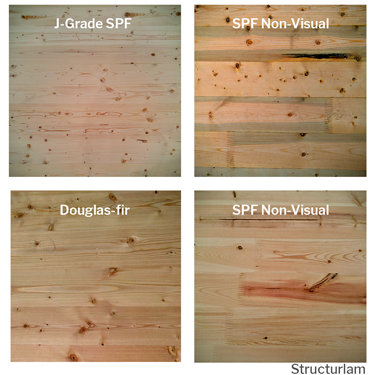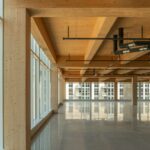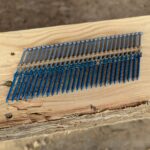Expert Tips
Specifying Appearance for CLT, NLT and Glulam
Information for designers seeking to specify appearance for cross-laminated timber (CLT), nail-laminated timber (NLT), or glue-laminated timber (glulam).

For mass timber, specification of appearance varies by product. Aesthetic expectations for cross-laminated timber (CLT) and nail-laminated timber (NLT) are agreed upon between the building designer and manufacturer/fabricator and described in the product specifications, whereas for glued-laminated timber (glulam) are standardized. Historically, appearance classifications have also been referred to as “appearance grades.” However, the industry is moving away from this term because of the potential confusion with structural grades.
CLT Appearance
Starting with the 2015 version of the International Building Code (IBC), CLT has been prescriptively allowed in construction types where heavy/mass timber is permitted as long as it is manufactured in accordance with the ANSI/APA PRG 320 Standard for Performance-Rated Cross-laminated Timber (IBC 2303.1.4). Section 7.3 of PRG 320 states that “CLT panel appearance shall be as agreed upon between the end-user and the CLT manufacturer.” Appendix XI of PRG 320 lists options for architectural and industrial appearance as follows:
APPENDIX XI. EXAMPLES OF CLT APPEARANCE CLASSIFICATIONS (NON-MANDATORY)
This appendix contains examples of CLT appearance classifications for CLT panels manufactured with lumber laminations for reference only. These requirements are based on the appearance at the time of manufacturing. The actual CLT panel appearance requirements are recommended to be agreed upon between the end-user and the CLT manufacturer.
- X1-1 Architectural Appearance Classification
An appearance classification normally suitable for applications where appearance is an important, but not overriding consideration. Specific characteristics of this classification are as follows:
- In exposed surfaces, all knot holes and voids measuring over 3/4 in. (19 mm) are filled with a wood-tone filler or clear wood inserts selected for similarity with the grain and color of the adjacent wood.
- The face layers exposed to view are free of loose knots and open knot holes are filled.
- Knot holes do not exceed 3/4 in. (19 mm) when measured in the direction of the lamination length with the exception that a void may be longer than 3/4 in. (19 mm) if its area is not greater than 1/2 in. (323 mm).
- Voids greater than 1/16 in. (1.6 mm) wide created by edge joints appearing on the face layers exposed to view are filled.
- Exposed surfaces are surfaced smooth with no misses permitted.
2. X1-2. Industrial Appearance Classification
- Voids appearing on the edges of laminations need not be filled.
- Loose knots and knot holes appearing on the face layers exposed to view are not filled.
- Members are surfaced on face layers only and the appearance requirements apply only to these layers.
- Occasional misses, low laminations or wane (limited to the lumber grade) are permitted on the surface layers and are not limited in length.
Most North American manufacturers and building designers either follow the guidelines in Appendix XI, or include a section in the project specifications defining “non-exposed” and “exposed” appearance and stating the acceptable parameters for each (e.g. checking, knot size, color variation, etc.). Several CLT manufacturers provide documents outlining appearance options for the products they produce.
In Europe, terms such as WSI, ISI and NSI also relate to CLT appearance. However, they are rarely if ever used by North American manufacturers.
DLT and NLT Appearance
Since DLT and NLT do not have a recognized standard for production, it is up to the design team (usually the architect) to note requirements for appearance and quality of panels. As with CLT, this information is typically included in the project specifications.
The raw material that goes into DLT and NLT (usually 2x framing lumber) is standardized—in the IBC, the American Wood Council’s National Design Specification (NDS) for Wood Construction, and the American Lumber Standards Committee’s Voluntary Product Standard 20—so language from those sources can be a helpful starting point. The U.S. Nail-Laminated Timber Design & Construction Guide also includes discussion of appearance options. For example, it notes that the following surface characteristics can be specified:
- Species
- Lumber grade
- Eased or sharp edges
- Cross section size
See Section 2.1.2 of the NLT Guide for additional information and panel examples, which are helpful for establishing acceptable and unacceptable aesthetic characteristics. Appearance charts can be found in Appendix A.
Glulam Appearance Classifications
Glulam is manufactured to various appearance classifications—including Premium, Architectural, Industrial and Framing—for structural and architectural applications. These classifications distinguish various levels of natural growth and manufacturing characteristics that are visible on the glulam surfaces. They do not characterize or affect structural performance.
Of these classifications, Premium and Architectural are commonly used in applications where the member may be exposed and finishing may be desirable. Premium is usually specified where appearance is the primary design consideration; however, it is usually a custom order. Architectural classification is suitable for use in applications where appearance is important but not the main consideration. Several sub-categories, including Framing-L and Industrial-L are also available. These match their main appearance classifications with the exception that the outermost plies are laminated veneer lumber (LVL) rather than dimension lumber. Additional information regarding appearance classifications can be found in Chapter 12 of ANSI A190.1-2022 American National Standard for Wood Products: Structural Glued Laminated Timber.
Glulam is also available with either a smooth or a rough textured surface. Rough textured surfaces may require up to twice as much finish as smooth surfaces.
For additional resources see the technical note: Glulam Appearance Classifications for Construction Applications from APA.
Our Manufacturer & Supplier Directory is a great place to find and connect with wood product manufacturers. If you have any questions on specifying appearance grades for your project, email the WoodWorks Project Assistance Help Desk at help@woodworks.org



